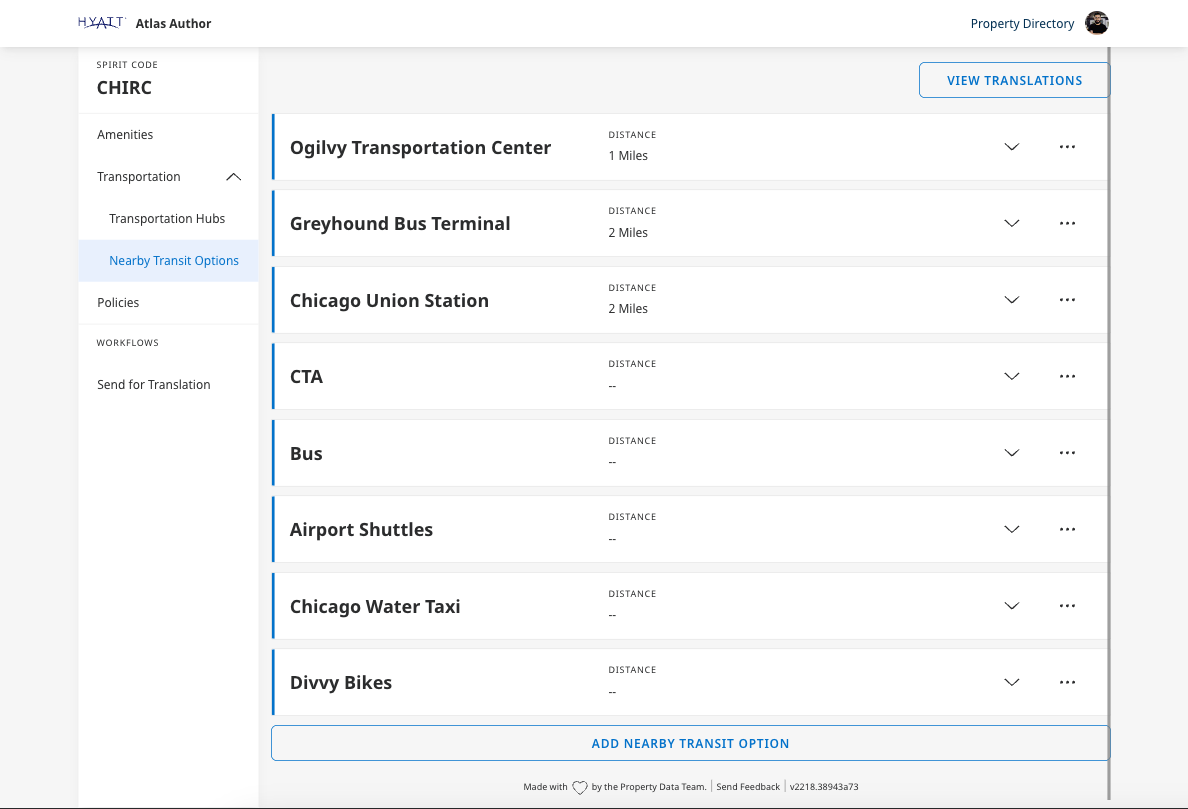HYATT HOTELSTitan MVP: Designing a Scalable & Intuitive UI for Hyatt’s Authoring Tool
December 2024
UX/UI case study showcasing the redesign of Hyatt's enterprise property management tool, transforming App-Atlas into Titan. Titan MVP was released into production on December 5th, 2024.
OVERVIEWHyatt’s legacy property management tool, App-Atlas, was reliable but outdated. As the Product Designer, I led the redesign to create Titan, a scalable and intuitive enterprise tool. This transformation addressed user frustrations, improved workflows, and ensured the system could grow with Hyatt’s evolving portfolio of over 1,400 properties.
THE PROBLEM1
Complex Interface: Endless scrolling and disorganized data blocks overwhelmed users.
2
Inefficient Workflows: Slow update processes caused bottlenecks.
3
Scalability Issues: The system couldn’t adapt to Hyatt’s growing data and feature requirements.
App-Atlas’ Interface
Screen recording with and example of App-Atlas’ endless scrolling, lack of hierarchy, and disorganized data blocks made navigation and content management cumbersome for users.
WHAT IS TITAN?Titan is a next-generation authoring tool designed to replace App-Atlas. It offers:
Modular and intuitive design solutions.
Improved workflows through automation.
Scalability to support Hyatt’s expanding global portfolio.
MY ROLEI was responsible for leading UX research, design strategy, and cross-functional collaboration to deliver Titan’s MVP. My contributions included:
Research & Insights
Conducted usability testing to identify user pain points and inefficiencies.
Led stakeholder workshops to prioritize features and align on design goals.
Gained deep insights through site visits to understand workflows at a property level.
User Persona
Meet Titan’s primary user: A Digital Content Manager responsible for handling complex property datasets. This persona guided every design decision, ensuring Titan addressed real-world challenges like navigation inefficiencies and data overload.
Journey Map
A detailed look at the user journey, mapping stages like data entry, version control, and content updates. This journey highlighted key pain points and opportunities to streamline workflows in Titan’s design.
Final Results from Prioritization Workshop
Conducted with Content team members where level of importance and feasibility were discussed for each feature. The results of this workshop helped us define our MVP and initial features. It also gave us important needs to be considered in post-MVP work.
Design Strategy
Whitespace and Clarity
Introduced ample whitespace to reduce cognitive load and improve focus.
Primary vs. Secondary Information
Organized data using a clear hierarchy with primary information visible and secondary data collapsible.
Modular Design
Designed Titan as a system of modular blocks, allowing users to manage smaller chunks of data like amenities and policies efficiently.
Cross-Functional Collaboration
Worked with engineers to align designs with technical feasibility and backend structures.
Partnered with product managers to balance user needs with business goals.
Advocated for data-driven decisions, ensuring usability remained a priority throughout development.
KEY DESIGN DECISIONSVertical Stackable Views
Improved navigation and allowed users to focus on relevant content.
Collapsible Sections
Reduced information overload, letting users expand only what they need.
Responsive Design
Optimized for large screens and split-screen scenarios.
EXPECTED OUTCOMEThough App-Atlas is an existing colleague-facing application, its outdated structure also means that there are no existing benchmarks or KPIs. Titan has been built with that in mind and we’ll be able to start measuring our success over time from day one.
Our hypotheses include:
Early usability tests will show increased user satisfaction and significant improvements in efficiency.
Automation will reduce content update times, addressing a major pain point.
Titan’s scalable design lays the foundation for future expansion, including potential use by hotel-level staff.
Seamless integration with Hyatt’s Enterprise Design System will ensure consistency across tools and platforms.
CONCLUSIONTitan exemplifies the power of user-centered design and cross-functional collaboration. By reimagining property data management, we created a tool that empowers teams to work smarter and scale with Hyatt’s future needs.
SEE THE WORK





RELATED ARTICLES